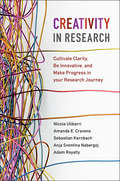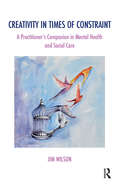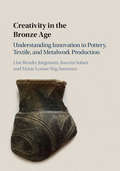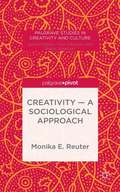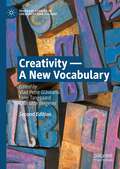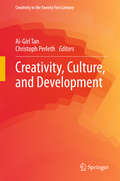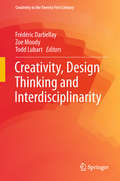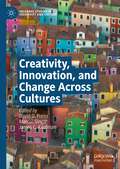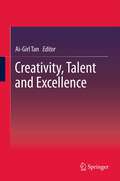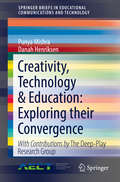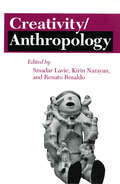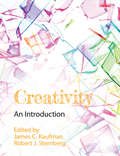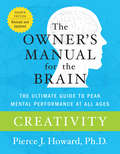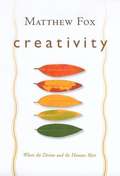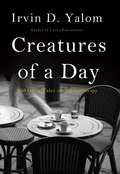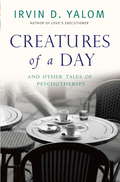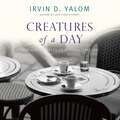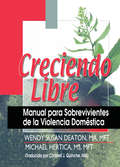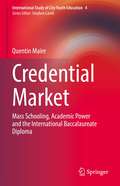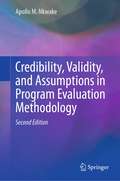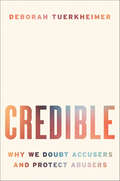- Table View
- List View
Creativity in Research: Cultivate Clarity, Be Innovative, and Make Progress in your Research Journey
by Nicola Ulibarri Amanda E. Cravens Anja Svetina Nabergoj Sebastian Kernbach Adam RoyaltyCreativity is at the heart of successful research, yet researchers are rarely taught how to manage their creative process, and modern academic life is not structured to optimize creativity. Creativity in Research provides concrete guidance on developing creativity for anyone doing or mentoring research. Based on a curriculum developed at Stanford University's Hasso Plattner Institute of Design, this book presents key abilities that underlie creative research practice through a combination of scientific literature on creative confidence, experiential exercises, and guided reflection. By focusing attention on how research happens as well as its outputs, researchers increase their ability to address research challenges and produce the outputs they care about. Simultaneously, they may also transform their emotional relationship with their work, replacing stress and a harsh inner critic with a more open and emotionally empowered attitude.
Creativity in Times of Constraint: A Practitioner's Companion in Mental Health and Social Care (The Systemic Thinking and Practice Series)
by Jim WilsonContemporary practices in mental health (and social care) are increasingly characterized by approaches that overly simplify social, political, and psychological concerns. The persistence and ubiquity of models designated to tackle diagnoses through focused technologies serve to minimize the human encounter in all its relational and systemic complexity. Practice becomes a technological activity instead of one concerned with the unique creative potential in meeting with others in therapy. With the growth of privatized mental health services, many practitioners are facing a plethora of "Must Do's" that focus on measurable outcomes, with clear goals and cost effective treatments. Yet, in practice, such apparent clarity of purpose often leads to bureaucratic clutter and risk aversion instead of clearing the decks for creativity. The focus of this book is how the practitioner or therapist can navigate around current practices in order to avoid falling into the rapids of quick fix solutions, whilst staying afloat to find realistic outcomes to human dilemmas that are brought to us.
Creativity in the Bronze Age: Understanding Innovation in Pottery, Textile, and Metalwork Production
by Marie Louise Stig Sørensen Lise Bender Jørgensen Joanna SofaerStudies of creativity frequently focus on the modern era yet creativity has always been part of human history. This book explores how creativity was expressed through the medium of clay in the Bronze Age in the Carpathian Basin. Although metal is one of the defining characteristics of Bronze Age Europe, in the Carpathian Basin clay was the dominant material in many areas of life. Here the daily experience of people was, therefore, much more likely to be related to clay than bronze. Through eight thematic essays, this book considers a series of different facets of creativity. Each essay combines a broad range of theoretical insights with a specific case study of ceramic forms, sites or individual objects. This innovative volume is the first to focus on creativity in the Bronze Age and offers new insights into the rich and complex archaeology of the Carpathian Basin.
Creativity – A Sociological Approach
by Monika E. Reuter Hao TanIntroducing the first macro-sociological perspective on the concept of creativity this book includes a review of ten domains which have studied creativity. It also explores the results of a six-year on-going research project comparing students' ideas on creativity with employers' and industry professionals' views.
Creativity — A New Vocabulary (Palgrave Studies in Creativity and Culture)
by Vlad Petre Glăveanu Lene Tanggaard Charlotte WegenerCreativity — A New Vocabulary proposes a novel approach to the way in which we talk and think about creativity. It covers a variety of topics not commonly associated with creativity that offer us valuable insights and open up new and exciting possibilities for creative action. This second edition includes six new essays which continue to challenge the traditional vocabulary of creativity and its preference for individuals, brains, cognition, personality, divergent thinking, insight, and problem solving. The book proposes a more dynamic and relational perspective that considers creativity as an embodied, social, material, and cultural process. This book will be useful for a wide range of specialists within the humanities and social sciences, as well as practitioners from applied fields who are looking for novel ways, of thinking about and doing creative work.
Creativity, Culture, and Development (Creativity in the Twenty First Century)
by Ai-Girl Tan Christoph PerlethThis volume presents a collection of writings on the relations among creativity, culture and development. The editors invited "like-minded" researchers of creativity from around the world to share their respective notions of creativity. Given that human creativity is a potential that can and should be nurtured in the course of lifespan development and across all cultural backgrounds, the volume emphasizes the importance of promoting creativity in all cultures and through societal-educational opportunities, and offers a venue for the authors to make conceptual, empirical and practical inquiries into the relations among creativity, development and culture. The authors represent a varied "mix" of contemporary and emerging creativity researchers who use different methodologies to investigate the importance of culture in creativity development and the reciprocal role of developing creativity and cultural enrichment. The volume represents an attempt on the part of the editors and the authors to broaden our current understanding of creativity in the contexts of human and cultural development, and in so doing to enhance our understanding of creativity, culture and development in the contexts of flourishing human and societal activities. As the first volume in a book series on "Creativity in the Twenty-First Century", the book invites readers and researchers to engage in future interdisciplinary and intercultural discourses and dialogues on the importance of creativity for human and cultural development.
Creativity, Design Thinking and Interdisciplinarity (Creativity in the Twenty First Century)
by Frédéric Darbellay Zoe Moody Todd LubartThis book, at the crossroads of creativity, design and interdisciplinary studies, offers an overview of these major trends in scientific research, society, culture and economics. It brings together different approaches and communities around a common reflection on interdisciplinary creative design thinking. This collective effort provides a unique dialogical and convergent space that deals with the challenges and opportunities met by researchers and practitioners working on design thinking, creativity and inter- and transdisciplinarity, or at the interface between these areas.
Creativity, Innovation, and Change Across Cultures (Palgrave Studies in Creativity and Culture)
by James C. Kaufman Marcos Singer David D. PreissThis book offers interdisciplinary, multicultural, and international perspectives on the interrelation between culture, innovation, change and creative forces. Its wide-ranging contributions present theoretical and empirical approaches and with reference to different domains across disciplines including psychology, education, social sciences, humanities, and engineering. The authors demonstrate how urgent social, environmental, technological, and economic challenges can benefit from individual, and community creativity to effect change. In this volume, “culture” refers to sociocultural differences, educational culture, media culture, organizational culture, technological culture, ethnic differences within a culture, and digital culture. Its contributors offer fresh insights on how creativity, innovation, and change can propel us forward and offer hope for the future across these many different forms of culture. They offer both granular studies of creativity and innovation at work in particular contexts and macro-level discussion on how they affect organizational culture, the culture of a discipline and society at large. This cross-cultural analysis of creativity, innovation and approaches to change will particularly appeal to practitioners and researchers in the fields of psychology, organizational behavior and education.
Creativity, Talent and Excellence
by Ai-Girl TanThis volume reflects the multiplicity of perspectives in the theory and practice of creativity, while it is broadly accepted that the dynamism of humanity's responses to our evolving scientific, social and environmental needs depends on our creativity. It examines the central issues that animate the themes of creativity, talent development and excellence in schools and in the workplace, as well as analysing their related socio-cultural activities and processes. Forged in the workshops of a number of conferences and symposia, this collection represents in itself a creative partnership between European and Asian academics. Thus it includes contributions from various cultural and organizational settings, as well as chapters that enhance our conceptual models of creativity in both learning and teaching. The contributing authors recognize that exploring the nature of creativity necessitates a new paradigm in research and praxis in which integration, collaboration, and the synthesis of knowledge and expertise are key factors. Their chapters detail the results of studies relating to to creativity, talent, school excellence, team and goal setting, innovation and organizational excellence, resilience, self-regulation, and personal epistemology. Clearly defined sections take on discrete aspects of the topic that include a vital assessment of the challenges that lie ahead in fostering the creativity, talent and excellence of the young and in doing so, allowing them to play a positive and innovative role in a variety of social contexts.
Creativity, Technology & Education: Exploring their Convergence (SpringerBriefs in Educational Communications and Technology)
by Danah Henriksen Punya MishraIn this collection of beautifully written essays, Mishra, Henriksen, and the Deep-play Research Group challenge myths about technology and creativity, debate time-honored instructional practices, and play with new ideas for schools to care for and nurture, rather than constrain, creativity. These essays are provocative . . . refreshing, [and] insightful --Dr. Yong Zhao, Foundation Distinguished Professor, University of Kansas and Fellow, Mitchell Institute for Health and Education Policy, Victoria University, Australia. What is creativity? Why is it important? What does it look like across different disciplines and contexts? What role does technology play, if any, in the creative process? And finally, what do creativity and technology have to do with education? These are the questions that underlie the collection of articles in this book. These essays provide a broad analytic frame for thinking about creativity, technology and education and describe classroom examples as well as strategies for evaluating creative artifacts and creative environments. All of these are grounded in specific examples from across a wide range of disciplines and contexts--art, mathematics, engineering, computer science, graphic design, architecture, science to name just a few. The final essays take a broader perspective on creativity and technology focusing both on our highly inter-connected YouTube world but also possibilities for the future. Creativity, Technology & Education: Exploring their Convergence is a vital resource for educators and practitioners as they seek to incorporate creative work and thoughtful pedagogy in their personal and professional lives.
Creativity, Wellbeing and Mental Health Practice (Palgrave Studies in Creativity and Culture)
by Tony GillamThis book argues that some aspects of mental health practice have become mechanical, joyless and uninspiring, leading to a loss of creativity and wellbeing. A high level of wellbeing is essential to mental health and contemporary mental health care – and creativity is at the heart of this. A greater awareness of everyday creativity, the arts and creative approaches to mental health practice, learning and leadership can help us reinvent and reinvigorate mental health care. This, combined with a clearer understanding of the complex concept of wellbeing, can enable practitioners to adopt fresh perspectives and roles that can enrich their work. Creativity and wellbeing are fundamental to reducing occupational stress and promoting professional satisfaction. Introducing a new model of creative mental health care combined with recommendations for wellbeing, Creativity, Wellbeing and Mental Health Practice is a practical, evidence-based book for students, practitioners and researchers in mental health nursing and related disciplines.
Creativity/Anthropology (The Anthropology of Contemporary Issues)
Creativity and play erupt in the most solemn of everyday worlds as individuals reshape traditional forms in the light of changing historical circumstances. In this lively volume, fourteen distinguished anthropologists explore the life of creativity in social life across the globe and within the study of ethnography itself. Contributors include Barbara A. Babcock, Edward M. Bruner, James W. Fernandez, Don Handelman, Smadar Lavie, José E. Limon, Barbara Myerhoff, Kirin Narayan, Renato Rosaldo, Richard Schechner, Edward L. Schieffelin, Marjorie Shostak, Anna Lowenhaupt Tsing, and Edith Turner.
Creativity: An Introduction (Essays In Cognitive Psychology Ser.)
by Robert J. Sternberg James C. KaufmanThis textbook is a systematic and straightforward introduction to the interdisciplinary study of creativity. Each chapter is written by one or more of the world's experts and features the latest research developments, alongside foundational knowledge. Each chapter also includes an introduction, key terms, and critical thought questions to promote active learning. Topics and authors have been selected to represent a comprehensive and balanced overview. Any reader will come away with a deeper understanding of how creativity is studied – and how they can improve their own creativity.
Creativity: The Owner's Manual
by Pierce HowardCutting-edge, user-friendly, and comprehensive: the revolutionary guide to the brain, now fully revised and updatedAt birth each of us is given the most powerful and complex tool of all time: the human brain. And yet, as we well know, it doesn't come with an owner's manual--until now. In this unsurpassed resource, Dr. Pierce J. Howard and his team distill the very latest research and clearly explain the practical, real-world applications to our daily lives. Drawing from the frontiers of psychology, neurobiology, and cognitive science, yet organized and written for maximum usability, The Owner's Manual for the Brain, Fourth Edition, is your comprehensive guide to optimum mental performance and well-being. It should be on every thinking person's bookshelf. What are the ingredients of happiness? Which are the best remedies for headaches and migraines? How can we master creativity, focus, decision making, and willpower? What are the best brain foods? How is it possible to boost memory and intelligence? What is the secret to getting a good night's sleep? How can you positively manage depression, anxiety, addiction, and other disorders? What is the impact of nutrition, stress, and exercise on the brain? Is personality hard-wired or fluid? What are the best strategies when recovering from trauma and loss? How do moods and emotions interact? What is the ideal learning environment for children? How do love, humor, music, friendship, and nature contribute to well-being? Are there ways of reducing negative traits such as aggression, short-temperedness, or irritability? What is the recommended treatment for concussions? Can you delay or prevent Alzheimer's and dementia? What are the most important ingredients to a successful marriage and family? What do the world's most effective managers know about leadership, motivation, and persuasion? Plus 1,000s more topics!
Creativity: Understanding Innovation in Problem Solving, Science, Invention, and the Arts
by Robert W. WeisbergHow cognitive psychology explains human creativity Conventional wisdom holds that creativity is a mysterious quality present in a select few individuals. The rest of us, the common view goes, can only stand in awe of great creative achievements: we could never paint Guernica or devise the structure of the DNA molecule because we lack access to the rarified thoughts and inspirations that bless geniuses like Picasso or Watson and Crick. Presented with this view, today's cognitive psychologists largely differ finding instead that "ordinary" people employ the same creative thought processes as the greats. Though used and developed differently by different people, creativity can and should be studied as a positive psychological feature shared by all humans. Creativity: Understanding Innovation in Problem Solving, Science, Invention, and the Arts presents the major psychological theories of creativity and illustrates important concepts with vibrant and detailed case studies that exemplify how to study creative acts with scientific rigor. Creativity includes: * Two in-depth case studies--Watson and Crick's modeling of the DNA structure and Picasso's painting of Guernica-- serve as examples throughout the text * Methods used by psychologists to study the multiple facets of creativity * The "ordinary thinking" or cognitive view of creativity and its challengers * How problem-solving and experience relate to creative thinking * Genius and madness and the relationship between creativity and psychopathology * The possible role of the unconscious in creativity * Psychometrics--testing for creativity and how personality factors affect creativity * Confluence theories that use cognitive, personality, environmental, and other components to describe creativity Clearly and engagingly written by noted creativity expert Robert Weisberg, Creativity: Understanding Innovation in Problem Solving, Science, Invention, and the Arts takes both students and lay readers on an in-depth journey through contemporary cognitive psychology, showing how the discipline understands one of the most fundamental and fascinating human abilities. "This book will be a hit. It fills a large gap in the literature. It is a well-written, scholarly, balanced, and engaging book that will be enjoyed by students and faculty alike." --David Goldstein, University of Toronto
Creativity: Where the Divine and the Human Meet
by Matthew Fox"I do not know any area of human potential more important if we are to be a sustainable species again. Creativity, when all is said and done, may be the best thing our species has going for it. It is also the most dangerous. I explore creativity here in the following manner: First I ask: How essential is creativity to our human nature? Chapters 1 and 2 explore this question: chapter 1 by exposing pseudo-meanings of being human, chapter 2 by proposing that creativity is our real nature. Creativity constitutes the very meaning of being human, and our powers of creativity distinguish us from other species. Evil, as well as profound goodness, transpires through our creativity. Chapter 3 poses the question: "Where does creativity comes from?" Chapter 4 speaks of the Divine imagination that takes us into our creativity, as mystics have always taught and recognized. Chapter 5 considers two myths about creativity and its consequences: the Prometheus-Hercules myth and the Adam-Jesus Christ myth. Chapter 6 considers the obstacles to creativity that must be removed for creativity to flow-what is holding us back? Chapter 7 asks how we can tap more fully into our creative power, and chapter 8 speaks to cultural benefits that will flow when we bring creativity to bear on education, everyday life and relationships, politics and worship. Creativity assists us to move as a species to our next level of evolution. When we consider creativity, we are considering the most elemental and innermost and deeply spiritual aspects of our beings. The great thirteenth-century mystic Meister Eckhart asks: "What is it that remains?" And his answer is: "That which is inborn in me remains." That which we give birth to from our depths is that which lives on after us. That which is inborn in us constitutes our most intimate moments-intimate with self, intimate with God the Creative Spirit, and intimate with others."
Creators On Creating: Awakening and Cultivating the Imaginative Mind
by Frank Barron Alfonso Montuori Anthea BarronThis collection of over three dozen essays ponders the essence of creativity. Includes selections from Henry Miller, Federico Fellini, Rainer Maria Rilke, Isadora Duncan, Frank Zappa, and Mary Shelley. A New Consciousness Reader.
Creatures of a Day: And Other Tales of Psychotherapy
by Irvin D. YalomIn his long career, eminent psychotherapist and author Irvin Yalom has pressed his patients and readers to grapple with life’s two greatest challenges: that we all must die, and that each of us is responsible for leading a life worth living. In Creatures of a Day, he and his patients confront the difficulty of these challenges. Although these people have come to Yalom seeking relief, recognition, or meaning, he and they discover that such things are rarely found in the places where we think to look. Like Love’s Executioner and Yalom’s other writing, Creatures of a Day provides an intelligent, compassionate, yet still unflinching look at the human soul and all the pain, confusion, and hope that go with it. The power of these stories is amplified by Yalom’s reflections on his own life as he reckons with its inevitable end. Suffused with humor, great artistry, and a profound humanity, Creatures of a Day lays bare the necessary task we each face, each day, to make our own lives meaningful.
Creatures of a Day: And Other Tales of Psychotherapy
by Irvin YalomWhat makes life worth living? What can we do to lead meaningful lives? And how do we confront our inevitable end? In his long career, eminent psychotherapist and author Irvin Yalom has pressed his patients and readers to grapple with life's two greatest challenges: that we all must die, and that each of us is responsible for leading a life worth living. In Creatures of a Day, he and his patients face the difficulty of these challenges. Although these people have come to Yalom seeking relief, recognition, or meaning, he and they discover that such things are rarely found in the places where we think to look. Like Love's Executioner and Yalom's other writing, Creatures of a Day provides an intelligent, compassionate, yet still unflinching look at the human soul and all the pain, confusion, and hope that go with it. The power of these stories is amplified by Yalom's reflections on his own life as he reckons with its inevitable end. Suffused with humor, great artistry, and a profound humanity, Creatures of a Day lays bare the necessary task we each face, each day, to make our own lives meaningful.
Creatures of a Day: And Other Tales of Psychotherapy
by Irvin YalomWhat makes life worth living? What can we do to lead meaningful lives? And how do we confront our inevitable end? In his long career, eminent psychotherapist and author Irvin Yalom has pressed his patients and readers to grapple with life's two greatest challenges: that we all must die, and that each of us is responsible for leading a life worth living. In Creatures of a Day, he and his patients face the difficulty of these challenges. Although these people have come to Yalom seeking relief, recognition, or meaning, he and they discover that such things are rarely found in the places where we think to look. Like Love's Executioner and Yalom's other writing, Creatures of a Day provides an intelligent, compassionate, yet still unflinching look at the human soul and all the pain, confusion, and hope that go with it. The power of these stories is amplified by Yalom's reflections on his own life as he reckons with its inevitable end. Suffused with humor, great artistry, and a profound humanity, Creatures of a Day lays bare the necessary task we each face, each day, to make our own lives meaningful.
Creciendo Libre: Manual para Sobrevivientes de la Violencia Doméstica
by Michael Hertica Wendy Deaton Christell QuincheHelp your Spanish-speaking clients break the pattern of abuse! A workbook for your Spanish-speaking clients! Battered women often become so frightened, isolated, and self-doubting that they don&’t realize that they are being victimized. They may minimize the seriousness of the abuse and make excuses for the abuser. The checklists, questionnaires, and personal stories in Creciendo Libre can provide the shock of recognition they need to be able to say, "This is wrong. It has to end." Combining psychological insight with practical safety information, Creciendo Libre helps the reader to understand-and end-the vicious cycle of wooing, tension, violence, and remorse that characterizes all levels of domestic violence. It outlines a series of steps abused women can take to ensure their emotional and physical safety. Creciendo Libre offers both practical and psychological resources, including: lists of abusive behaviors from ridiculing family members to physical violence common rationalizations for abuse used by both victims and perpetrator detailed discussions of protection orders and other legal matters detailed preparations and safety precautions that may make leaving less dangerous advice on what to take with you when you leave guidelines for establishing safe relationships in the future Creciendo Libre provides readers with a straightforward, action-oriented approach to the problem of domestic violence. A companion volume available separately, A Therapist&’s Guide to Growing Free (available in English only), offers therapists a comprehensive outline of the issues, tasks, and goals involved in treatment with victims and survivors. Rompe el patrón del abuso-de una manera segura! Mujeres abusadas muchas veces llegan a temer, aislarse, y a auto dudarse al punto que no logran reconocer que estan siendo victimizadas. Ellas podran minimizar la seriedad del abuso y hacer excusas para encubrir al ofensor. Las listas, cuestionarios, y relatos personales en Creciendo Libre pueden proveer el susto necesario para que ellas reconozcan que, "Esto esta mal y tiene que terminar." Combina la revelación psicologica e información practica, para ayudar a que el lector de Creciendo Libre pueda entender y parar-el ciclo vicioso del cortejo, la tension, la violencia, y la culpabilidad que caracteriza todos los niveles de la violencia doméstica. Este libro delinea una serie de pasos para que la mujer abusada llege ha asequrar su seguridad emocional y física. Creciendo Libre ofrece recursos practicos y psicologicos incluyendo: listas de comportamientos abusivos desde la rediculización de los miembro de la familia hasta la violencia física racionalizaciones del abuso comunmente utilizadas por la victima y el ofensor una explicación detalladas sobre la orden de protección y otros asuntos legales preparación y medidas de precaución detalladamente explicados que puedan hacer que el irse sea menos peligroso consejos sobre lo que se debe llevar cuando decida irse guías para establezer una relación segura en un futuro Creciendo Libre provee al lector un metodo directo, orientado al la acción para resolver problemas sobre la violencia doméstica. El volumen que le acompaña esta separadamente disponible. El Guia del Terapeuta de Creciendo Libre, ofrece un esquema comprensivo de los asuntos, tareas, y metas impuestas en el tratamiento de las victimas y sobrevivientes.
Credential Market: Mass Schooling, Academic Power and the International Baccalaureate Diploma (International Study of City Youth Education #4)
by Quentin MaireThis book makes an original contribution to credential sociology by analysing how high school certificates become and remain valuable in a context of mass high school participation (i.e. credentialism). Building on a detailed analysis of the International Baccalaureate (IB) Diploma, a senior secondary school certificate offered in over 150 countries, Quentin Maire argues that the advent of new private credentials can be understood as a phenomenon of credential stratification in a context of intensified academic competition.Using original data on high school credentials in Australia and internationally, the author makes a strong case for certificates to be studied relationally, by locating them in the credentialing structures in which they are inserted. He systematically applies the comparative method to explain the role of the curriculum, family resources, school segregation and higher education selection in creating a credential hierarchy. His robust combination of theoretical construction and detailed empirical work allows him to offer new insights into social inequality in education systems, credential theory and the IB Diploma.
Credibility, Validity, and Assumptions in Program Evaluation Methodology
by Apollo M. NkwakeThis book focuses on methods of choice in program evaluation. Credible methods choice lies in the assumptions we make about the appropriateness and validity of selected methods and the validity of those assumptions. As evaluators make methodological decisions in various stages of the evaluation process, a number of validity questions arise. Yet unexamined assumptions are a risk to useful evaluation. The first edition of this book discussed the formulation of credible methodological arguments and methods of examining validity assumptions. However, previous publications suggest advantages and disadvantages of using various methods and when to use them. Instead, this book analyzes assumptions underlying actual methodological choices in evaluation studies and how these influence evaluation quality. This analysis is the basis of suggested tools. The second edition extends the review of methodological assumptions to the evaluation of humanitarian assistance. While evaluators of humanitarian action apply conventional research methods and standards, they have to adapt these methods to the challenges and constraints of crisis contexts. For example, the urgency and chaos of humanitarian emergencies makes it hard to obtain program documentation; objectives may be unclear, and early plans may quickly become outdated as the context changes or is clarified. The lack of up-to-date baseline data is not uncommon. Neither is staff turnover. Differences in perspective may intensify and undermine trust. The deviation from ideal circumstances challenges evaluation and calls for methodological innovation. And how do evaluators work with assumptions in non-ideal settings? What tools are most relevant and effective? This revised edition reviews major evaluations of humanitarian action and discusses strategies for working with evaluation assumptions in crises and stable program settings.
Credible: Why We Doubt Accusers and Protect Abusers
by Deborah TuerkheimerIn this landmark book, a former prosecutor, legal expert, and leading authority on sexual violence examines why we are primed to disbelieve allegations of sexual abuse—and how we can transform a culture and a legal system structured to dismiss accusers Sexual misconduct accusations spark competing claims: her word against his. How do we decide who is telling the truth? The answer comes down to credibility. But as this eye-opening book reveals, invisible forces warp the credibility judgments of even the well- intentioned among us. We are all shaped by a set of false assumptions and hidden biases embedded in our culture, our legal system, and our psyches. In Credible, Deborah Tuerkheimer provides a much-needed framework to explain how we perceive credibility, why our perceptions are distorted, and why these distortions harm survivors. Social hierarchies and inequalities foster doubt that is commonplace and predictable, resulting in what Tuerkheimer calls the “credibility discount”—our dismissal of claims by certain kinds of speakers—primarily women, and especially those who are more marginalized. The #MeToo movement has exposed how victims have been badly served by a system that is designed not to protect them, but instead to protect the status quo. Credibility lies at the heart of this system. Drawing on case studies, moving first-hand accounts, science, and the law, Tuerkheimer identifies widespread patterns and their causes, analyzes the role of power, and examines the close, reciprocal relationship between culture and law—guiding us toward accurate credibility judgments and equitable treatment of those whose suffering has long been disregarded.#MeToo has touched off a massive reckoning. To achieve lasting progress, we must shift our approach to belief. Credible helps us forge a path forward to ensuring justice for the countless individuals affected by sexual misconduct.
Credit and Blame
by Charles TillyIn his eye-opening book Why?, world-renowned social scientist Charles Tilly exposed some startling truths about the excuses people make and the reasons they give. Now he's back with further explorations into the complexities of human relationships, this time examining what's really going on when we assign credit or cast blame. Everybody does it, but few understand the hidden motivations behind it. With his customary wit and dazzling insight, Tilly takes a lively and thought-provoking look at the ways people fault and applaud each other and themselves. The stories he gathers in Credit and Blame range from the everyday to the altogether unexpected, from the revealingly personal to the insightfully humorous--whether it's the gushing acceptance speech of an Academy Award winner or testimony before a congressional panel, accusations hurled in a lover's quarrel or those traded by nations in a post-9/11 crisis, or a job promotion or the Nobel Prize. Drawing examples from literature, history, pop culture, and much more, Tilly argues that people seek not only understanding through credit and blame, but also justice. The punishment must fit the crime, accomplishments should be rewarded, and the guilty parties must always get their just deserts. Brilliantly conceived and masterfully written, Credit and Blame is a book that revolutionizes our understanding of the compliments we pay and the accusations we make.
